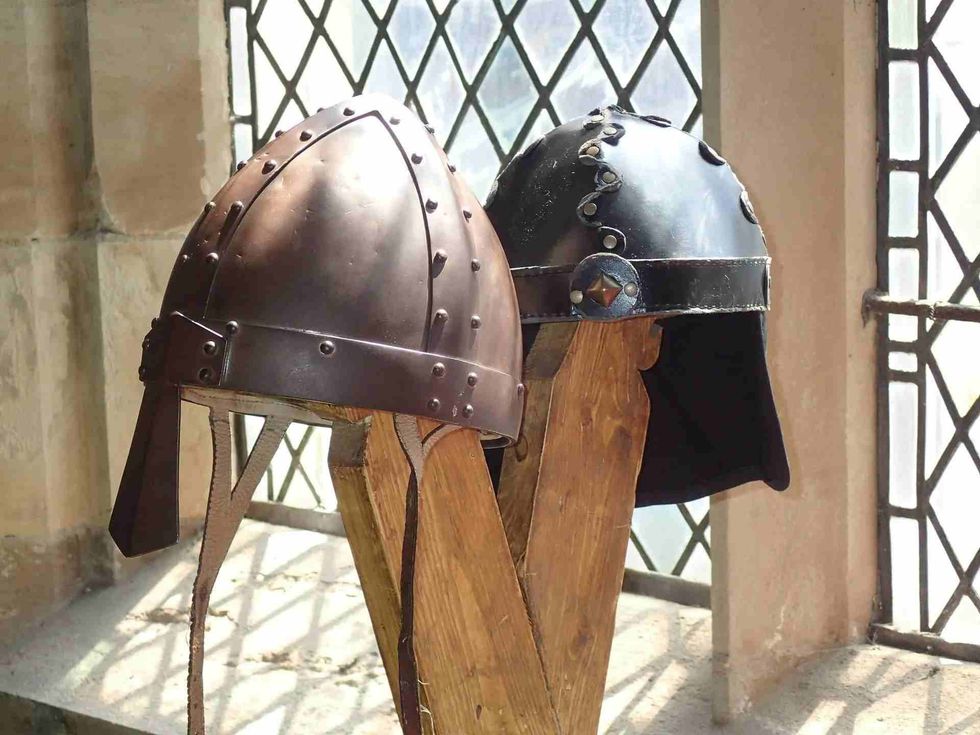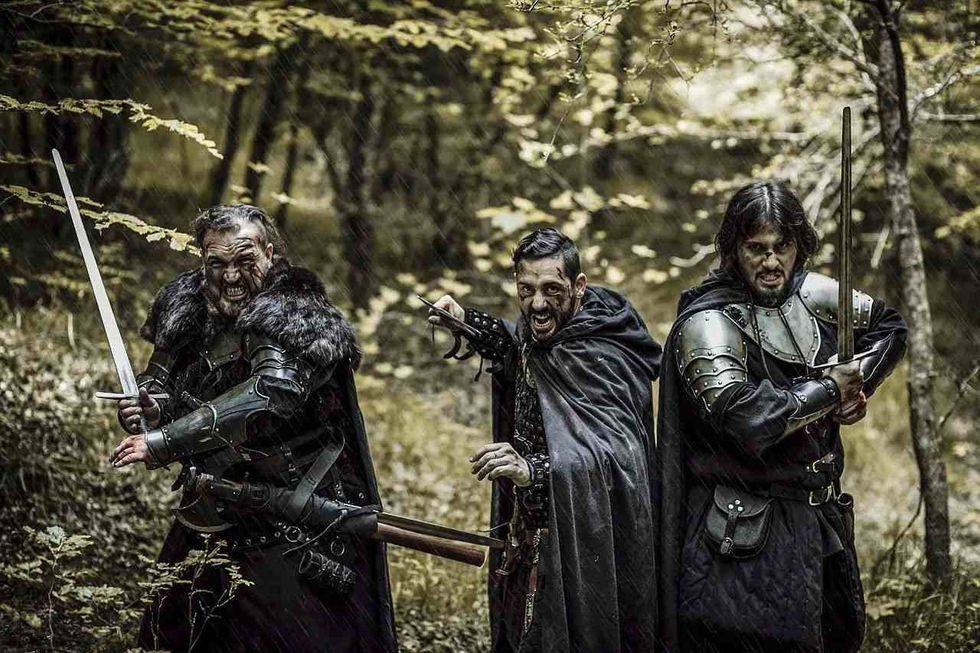Viking Armor Facts: How Strong Was It, What Did It Look Like, And More!

Vikings is the contemporary term given to seagoing people mainly from Scandinavia, that includes modern-day Denmark, Norway, and also Sweden, who looted, bootlegged, traded, and decided to settle all across Europe from the late 8th to 11th centuries.
Are you curious about the armor Viking warriors used to wear? Check out this article and find out some cool facts about Vikings and their weapons.
Vikings also went to the Mediterranean, northern Africa, Canada, Russia, Spain, the Gulf region, and France. This time frame is commonly known as the Viking Age in several of the countries they looted and resided in, and the word 'Viking' also commonly refers to the residents of the Scandinavian ancestral homes as a whole.
The Vikings had a significant impact on Scandinavian areas and the British Isles during the start of Middle Ages. Vikings formed Norse settlements and local authorities in the British Isles, using their distinctive longboats as skillful seamen and voyagers. They were the very first Europeans to arrive in North America, trying to settle briefly in Newfoundland.
While expanding Norse culture to other countries, they also managed to bring slaves, concubines, and multinational cultural traits back to Scandinavia, deeply affecting the biological and cultural composition of both places. The Norse ancestral lands were progressively merged from regional kingdoms into three main empires. They were Denmark, Norway, and Sweden.
The Vikings spoke a language called Old Norse and carved rune symbols. For the most part, they practiced the Norse paganism and worshiped Norse gods, but later converted to Christianity.
The Vikings would have their own set of laws, as well as their style of art and architectural styles. The majority of Vikings were also agriculture farmers, boatmen, artisans, and traders.
Popular perceptions of the Vikings frequently contrast with the complicated, advanced society of the Norsemen revealed by archaeologists and historical accounts. In the 18th century, a Norse mythology image of Vikings as noble savages began to surface.
Most popular fiction has had Vikings, who subtly deviate from the ones in reality. The dramatization of the portrayal in films gives these historical figures a fresh appearance. Their intimidating appearances thrill viewers, making them a well-liked figure in movies.
After reading interesting facts about the Viking Age and weapons of the Viking world, also check the Vikings in Ireland facts and how tall were Vikings.
Foreign Origins Of Viking Arms And Armor
Viking warriors were well-known for their ferocity. They sailed from their homes and launched surprise raids on other civilizations across Europe. Honor and glory in battle would be the only factors that lasted for years for a Viking warrior.
Viking men used large, wooden Viking shields gripped in the center from behind an iron boss during the Viking Age. A typical Viking shield was one of several instances where poetic and archaeological sources disagree on how Viking weapons were built for battle. It was a round shield made of wood or wrought iron which was a bit heavier.
It was believed in Viking society that if a Viking warrior died bravely in battle, he would go to Valhalla, which meant hall of fallen. The Norse society was divided into three groups or hierarchy. They were called the Thralls, the Karls, and the Jarls.
The Viking era typically refers to the centuries between late 700 century. a few years after the first documented attack, and the 11th century. The Viking era was a time in the Medieval Era when Norsemen recognized as Viking warriors raided, colonized, conquered, and traded across Europe and into North America.
Battle axes were the most standard hand weapon of many Vikings as Viking swords were much more costly to manufacture. Viking swords were only available to rich and powerful warriors.
The presence of ax heads in ancient finds is most likely due to their use as a weapon commonly used. This theory is backed by a sizable group of women uncovered in Scandinavian burial grounds where axes were also found.
Viking weaponry consisted of a variety of Viking weapons such as sword blades, axes, bows and arrows, lances, and spearheads. Shields, helmets, and chain mail were among the Viking weaponry used by Vikings to defend themselves in battle. The weapons they owned were determined by their economic ability.
Viking Clothing And Weapons
Viking spears were the most commonly used weapons among Scandinavian people in the Viking world. Throwing spears was a constant practice among the warrior class; contrary to popular belief, it was also the primary weapon of the Viking warrior, a natural fit for their tactics and strategies.
The spear weapons were composed of metalheads with a blade and a hollow shaft positioned on two to three-meter-long wooden shafts crafted of ash wood.
The richest Vikings who could afford to wear armor wore helmets, metal armor, and a type of armor called lamellar, which was made of iron panels stitched together. Sheets of quilted cloth, such as linen or wool were also used by lower-status Vikings to guard their bodies against the enemy army during battle.
The horned helmets that are seen in modern-day illustrations of Vikings aren't actually true. There is a lot of controversy around this topic, however, it is a fact that no horned helmets have actually been discovered at any Viking archaeological site.
Initial Viking swords were made from pure iron and these swords were notorious for bending in battle. Subsequently, Viking swords were crafted by pattern welding, a refined technique in which multiple thin sheets of metal are intricately intertwined together at high temperatures to build a powerful sword.
The typical Viking warrior's sword was 70 to 80 cm long, 4 to 6 cm wide at the hilt, dipping mildly toward the end, and weighed approximately ranging between 1-2 kg.
Although there was some specialization in architecture, the spear was used in battle as both a stabbing weapon as well as a slashing weapon. Lighter, relatively narrow spearheads were designed for flinging, while heavier, wider spearheads were designed for stabbing like swords.
Vikings were recognized to be very skillful weavers who made their own fabric for garments. Making garments was a lot more difficult in the Viking era than it is nowadays. The work was done completely by women, and it took a long time.
The Viking Age sling was simple to make, comprising of a cord and occasionally a leather cup to aid in loading, allowing many of the lower classes reach to a useful weapon. Owing to the lack of heavy machinery and expansive structure, slingers promoted efficient, light ground forces.
The bow and arrow were used for shooting animals as well as during battle. They were crafted of yew, ash, or elmwood. A 10th-century bow's weighed 90 lb (40.8 kg) or above, resulting in a more efficient range of at least 656.2 ft (200 m) based on the mass of the arrow.
Arrowheads were generally made of iron as well as created in numerous sizes and designs, as per their place of origin.
Often, these arrowheads were fixed onto the arrow beam by a shouldered tang that was made to fit into the later part of a shaft of wood. Some of the heads were constructed of timber, skeletal bones, or the antlers of stags.
The oldest discovery of these artifacts occurred in Denmark, and they appeared to belong to the leading-warrior category based on the cemeteries in which they had been discovered.
There were various classes of Vikings, so each group was expected to wear different types of clothing to demonstrate their riches or social standing. The upper classes began wearing more expensive clothing, which was sometimes rendered with silk.
They also wore headpieces, pendants, and armbands as jewelry. Furthermore, relatively wealthy Viking garments featured more adornment and color than lower-class Viking clothing, which was made from simple cloth.
Vikings also had gender-specific clothing available. Viking men wore tunics with a wide, loose skirt that was narrow from across the chest. They wore trousers with their tunics. Women wore a simple gown over an overdress. Garments were tied around the hips with leather straps and on top with connectors or ornaments for both males and females.
Viking ladies wore head coverings as well. This is not based on any major evidence as the head covering was not a part of religious belief while can be considered much of an hair accessory.
The average Viking attacked with a spear and a shield. They also held a seax, a sort of regular knife that served as both a utility knife and a weapon. Bows were used during both land and sea battles.
Wealthier Vikings possessed not only a spear and a shield but also a sword. Only the wealthiest Vikings, such as nobles or warriors, wore helmets and other armor.
Viking Warriors Depended On Maneuverability
One of the main reasons why Vikings could conquer the other nations so easily was the fact that Viking ships were great in maneuverability. They could easily go through the sea. The shape and the way the ships were built, played a major role in this.
Availability of plenty of sturdy wood products to meet the Vikings' high demand for ships was fortunately not a problem in the heavy forest region of Scandinavia, oak and pine were mostly used for ship building while pine has an advantage cause it was easily bendable over time enhancing ship curve.
The Vikings also preserved a wide network and many people gave them information, allowing them to attack precisely when financial assets and farm buildings were full, and with minimal resistance.
Vikings were often aware of where and when large crowds collected for trade fairs. The beginning of the Middle Ages was a turbulent time, and the Vikings realized how to take advantage of it.
Political and civil disorder and political conflicts usually meant that kings and princes were too busy attacking one another to safeguard their own towns or temples from the plundering Vikings. The Vikings exploited this opportunity and used their mobility to their advantage in their attacks.
Strikes were most probably meticulously designed and scheduled, whether by small roving bandits or huge Viking armed forces.
The majority of Vikings were competent warriors. They resided in turbulent times and idealized warrior heritage. All male Vikings were required to have accomplished weapons training in order to defend their settlements during breaches.
When they went for looting, it wasn't just a gang of bearded savages; it was well-educated troops who understood war and how to manage themselves during a war. Plus, the Vikings were not afraid to die. Instead, they considered themselves fortunate if they died bravely during a battle.
Large groups of Vikings settled around Europe over time, either by having conquered the land or by signing peace agreements with local leaders, occasionally pledging to protect the country they were in from other Vikings.
Battle axes used by Viking warriors employed a wide variety of head shapes. The cutting edge ranged from 3-6 in (7.6-15.2 cm). After some years, ax heads started becoming much larger and ranged from 9-18 in (22.9-45.7 cm) long. The long handle of an ax allowed the Viking warriors to have a longer reach in a fight.

Viking Lamellar Armor
In the early Middle Ages, lamellar armor was not as popular as other weapons. It is a popular misunderstanding that lamellar armor was only used by nomadic tribes in the Middle East. However, archaeological discoveries show that this type of armor was used in Scandinavian regions.
Vikings has influenced by the Byzantine Empire and the Kyivan Rus', according to historical sources, because some Vikings served as mercenaries for both communities. The earliest metal plates were discovered while excavating a Viking village in Sweden.
Lamellar armor is constructed from intersecting rows of steel scales held together by leather laces. The scales of lamellar armor were traditionally laced with leather because leather is highly durable and did not break easily. This factor was important as the armor needed to be sturdy at all times.
Torso And Body Armour For The Viking
To defend themselves, all Viking male soldiers would carry a round shield. The defensive weapons of a Viking were determined by his wealth. A wealthy individual may also own body armor and iron headgear. Chainmail was challenging to make and, no doubt, costly.
Helmets were essentially made as an iron bowl that shielded the head and, in many cases, had a nose portion to safeguard the face. In the absence of chainmail, less well-off Vikings decided to wear thick, stuffed leather clothing that provided some security from bladed weapons.
Viking shields could measure up to a 13mm in width. They were crafted of riveted wooden boards with a central hole for a wooden handle. Shields were also ornately designed, with some colors like red, white, and yellow.
Vikings were able to conquer large portions of England, France, and Russia using these simple but powerful weapons. Vikings' recognition as fearsome warriors was built on their hard-won muscular builds and fierceness in battle.
A few uncovered runestones seem to portray armor, but it is highly probable that it is not chain mail. The armor in question could have been the previously mentioned lamellar armor, or it could not have been body armor at all.
Multiple layers of strong cloth or hemp canvas, as well as warm clothing made of thick woolen fabric, would have also provided Vikings with adequate protection at an affordable price.
We Want Your Photos!
More for You
Bachelor of Arts specializing in Linguistics

Martha MartinsBachelor of Arts specializing in Linguistics
Martha is a full-time creative writer, content strategist, and aspiring screenwriter who communicates complex thoughts and ideas effectively. She has completed her Bachelor's in Linguistics from Nasarawa State University. As an enthusiast of public relations and communication, Martha is well-prepared to substantially impact your organization as your next content writer and strategist. Her dedication to her craft and commitment to delivering high-quality work enables her to create compelling content that resonates with audiences.
Disclaimer
1) Kidadl is independent and to make our service free to you the reader we are supported by advertising. We hope you love our recommendations for products and services! What we suggest is selected independently by the Kidadl team. If you purchase using the Buy Now button we may earn a small commission. This does not influence our choices. Prices are correct and items are available at the time the article was published but we cannot guarantee that on the time of reading. Please note that Kidadl is a participant in the Amazon Services LLC Associates Program, an affiliate advertising program designed to provide a means for sites to earn advertising fees by advertising and linking to Amazon. We also link to other websites, but are not responsible for their content.
2) At Kidadl, we strive to recommend the very best activities and events. We will always aim to give you accurate information at the date of publication - however, information does change, so it’s important you do your own research, double-check and make the decision that is right for your family. We recognise that not all activities and ideas are appropriate for all children and families or in all circumstances. Our recommended activities are based on age but these are a guide. We recommend that these ideas are used as inspiration, that ideas are undertaken with appropriate adult supervision, and that each adult uses their own discretion and knowledge of their children to consider the safety and suitability. Kidadl cannot accept liability for the execution of these ideas, and parental supervision is advised at all times, as safety is paramount. Anyone using the information provided by Kidadl does so at their own risk and we can not accept liability if things go wrong.
3) Because we are an educational resource, we have quotes and facts about a range of historical and modern figures. We do not endorse the actions of or rhetoric of all the people included in these collections, but we think they are important for growing minds to learn about under the guidance of parents or guardians.







